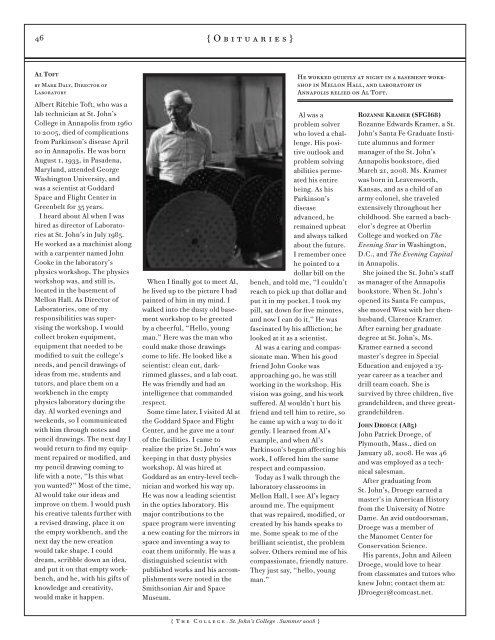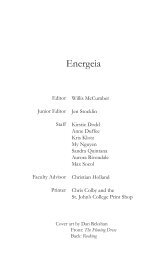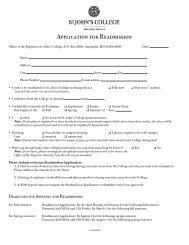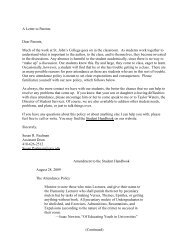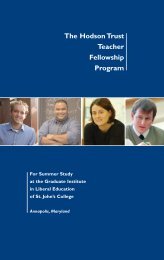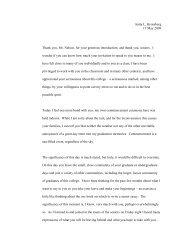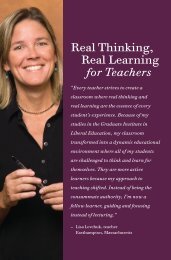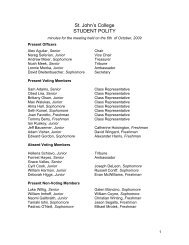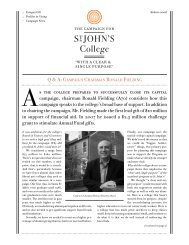Magazine - summer 03 - St. John's College
Magazine - summer 03 - St. John's College
Magazine - summer 03 - St. John's College
Create successful ePaper yourself
Turn your PDF publications into a flip-book with our unique Google optimized e-Paper software.
46<br />
{Obituaries}<br />
AL TOFT<br />
by Mark Daly, Director of<br />
Laboratory<br />
Albert Ritchie Toft, who was a<br />
lab technician at <strong>St</strong>. John’s<br />
<strong>College</strong> in Annapolis from 1960<br />
to 2005, died of complications<br />
from Parkinson’s disease April<br />
20 in Annapolis. He was born<br />
August 1, 1933, in Pasadena,<br />
Maryland, attended George<br />
Washington University, and<br />
was a scientist at Goddard<br />
Space and Flight Center in<br />
Greenbelt for 35 years.<br />
I heard about Al when I was<br />
hired as director of Laboratories<br />
at <strong>St</strong>. John’s in July 1985.<br />
He worked as a machinist along<br />
with a carpenter named John<br />
Cooke in the laboratory’s<br />
physics workshop. The physics<br />
workshop was, and still is,<br />
located in the basement of<br />
Mellon Hall. As Director of<br />
Laboratories, one of my<br />
responsibilities was supervising<br />
the workshop. I would<br />
collect broken equipment,<br />
equipment that needed to be<br />
modified to suit the college’s<br />
needs, and pencil drawings of<br />
ideas from me, students and<br />
tutors, and place them on a<br />
workbench in the empty<br />
physics laboratory during the<br />
day. Al worked evenings and<br />
weekends, so I communicated<br />
with him through notes and<br />
pencil drawings. The next day I<br />
would return to find my equipment<br />
repaired or modified, and<br />
my pencil drawing coming to<br />
life with a note, “Is this what<br />
you wanted?” Most of the time,<br />
Al would take our ideas and<br />
improve on them. I would push<br />
his creative talents further with<br />
a revised drawing, place it on<br />
the empty workbench, and the<br />
next day the new creation<br />
would take shape. I could<br />
dream, scribble down an idea,<br />
and put it on that empty workbench,<br />
and he, with his gifts of<br />
knowledge and creativity,<br />
would make it happen.<br />
When I finally got to meet Al,<br />
he lived up to the picture I had<br />
painted of him in my mind. I<br />
walked into the dusty old basement<br />
workshop to be greeted<br />
by a cheerful, “Hello, young<br />
man.” Here was the man who<br />
could make those drawings<br />
come to life. He looked like a<br />
scientist: clean cut, darkrimmed<br />
glasses, and a lab coat.<br />
He was friendly and had an<br />
intelligence that commanded<br />
respect.<br />
Some time later, I visited Al at<br />
the Goddard Space and Flight<br />
Center, and he gave me a tour<br />
of the facilities. I came to<br />
realize the prize <strong>St</strong>. John’s was<br />
keeping in that dusty physics<br />
workshop. Al was hired at<br />
Goddard as an entry-level technician<br />
and worked his way up.<br />
He was now a leading scientist<br />
in the optics laboratory. His<br />
major contributions to the<br />
space program were inventing<br />
a new coating for the mirrors in<br />
space and inventing a way to<br />
coat them uniformly. He was a<br />
distinguished scientist with<br />
published works and his accomplishments<br />
were noted in the<br />
Smithsonian Air and Space<br />
Museum.<br />
He worked quietly at night in a basement workshop<br />
in Mellon Hall, and laboratory in<br />
Annapolis relied on Al Toft.<br />
Al was a<br />
problem solver<br />
who loved a challenge.<br />
His positive<br />
outlook and<br />
problem solving<br />
abilities permeated<br />
his entire<br />
being. As his<br />
Parkinson’s<br />
disease<br />
advanced, he<br />
remained upbeat<br />
and always talked<br />
about the future.<br />
I remember once<br />
he pointed to a<br />
dollar bill on the<br />
bench, and told me, “I couldn’t<br />
reach to pick up that dollar and<br />
put it in my pocket. I took my<br />
pill, sat down for five minutes,<br />
and now I can do it.” He was<br />
fascinated by his affliction; he<br />
looked at it as a scientist.<br />
Al was a caring and compassionate<br />
man. When his good<br />
friend John Cooke was<br />
approaching 90, he was still<br />
working in the workshop. His<br />
vision was going, and his work<br />
suffered. Al wouldn’t hurt his<br />
friend and tell him to retire, so<br />
he came up with a way to do it<br />
gently. I learned from Al’s<br />
example, and when Al’s<br />
Parkinson’s began affecting his<br />
work, I offered him the same<br />
respect and compassion.<br />
Today as I walk through the<br />
laboratory classrooms in<br />
Mellon Hall, I see Al’s legacy<br />
around me. The equipment<br />
that was repaired, modified, or<br />
created by his hands speaks to<br />
me. Some speak to me of the<br />
brilliant scientist, the problem<br />
solver. Others remind me of his<br />
compassionate, friendly nature.<br />
They just say, “hello, young<br />
man.”<br />
ROZANNE KRAMER (SFGI68)<br />
Rozanne Edwards Kramer, a <strong>St</strong>.<br />
John’s Santa Fe Graduate Institute<br />
alumnus and former<br />
manager of the <strong>St</strong>. John’s<br />
Annapolis bookstore, died<br />
March 21, 2008. Ms. Kramer<br />
was born in Leavenworth,<br />
Kansas, and as a child of an<br />
army colonel, she traveled<br />
extensively throughout her<br />
childhood. She earned a bachelor’s<br />
degree at Oberlin<br />
<strong>College</strong> and worked on The<br />
Evening <strong>St</strong>ar in Washington,<br />
D.C., and The Evening Capital<br />
in Annapolis.<br />
She joined the <strong>St</strong>. John’s staff<br />
as manager of the Annapolis<br />
bookstore. When <strong>St</strong>. John’s<br />
opened its Santa Fe campus,<br />
she moved West with her thenhusband,<br />
Clarence Kramer.<br />
After earning her graduate<br />
degree at <strong>St</strong>. John’s, Ms.<br />
Kramer earned a second<br />
master’s degree in Special<br />
Education and enjoyed a 15-<br />
year career as a teacher and<br />
drill team coach. She is<br />
survived by three children, five<br />
grandchildren, and three greatgrandchildren.<br />
JOHN DROEGE (A85)<br />
John Patrick Droege, of<br />
Plymouth, Mass., died on<br />
January 28, 2008. He was 46<br />
and was employed as a technical<br />
salesman.<br />
After graduating from<br />
<strong>St</strong>. John’s, Droege earned a<br />
master’s in American History<br />
from the University of Notre<br />
Dame. An avid outdoorsman,<br />
Droege was a member of<br />
the Manomet Center for<br />
Conservation Science.<br />
His parents, John and Aileen<br />
Droege, would love to hear<br />
from classmates and tutors who<br />
knew John; contact them at:<br />
JDroege1@comcast.net.<br />
{ The <strong>College</strong> • <strong>St</strong>. John’s <strong>College</strong> • Summer 2008 }


